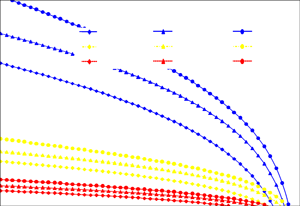Binary integration performance analysis of CA family of CFAR strategies in homogeneous Weibull clutter
DOI:
https://doi.org/10.3103/S0735272720010033Keywords:
CFAR detection processors, Weibull clutter, CA adaptive detection family, binary integration, target fluctuation modelAbstract
The exact knowledge of the clutter properties is of great importance for modern radar systems due to the role that they are directly play mainly through the CFAR processor design in the optimization of the detection process. Owing to the central limit theorem, the most used models are of Gaussian distribution that has the feature of simple processing architectures. Actually, these models are expected to represent, to a good extent, the sea and terrain clutters for poor-resolution and largely grazing angle radar. If any of these two practical situations is no longer satisfied, these models become insufficient for the clutter representation. Under these circumstances, the clutter becomes spikier and this successively leads to a false alarm rate behavior, which is much more important than that predicted by a Gaussian model. For that reason, other models, which are capable of taking into account these types of operating conditions, have to be investigated. This is typically needed for the case of high-resolution radars. The developed clutter models will allow us to reduce the intensity of clutter, through the reduction of the analyzed cell resolution and, consequently, the signal-to-noise ratio will be improved. Accordingly, the target detection probability should increase. Weibull represents one of the most suitable distributions for the high-resolution land clutter modeling. On the other hand, due to the simplicity of binary integrator and its robustness in non-Gaussian clutter, it has been widely used in radar detectors. This paper is interested in evaluating the detection performance of the CA (Cell-Averaging) family of CFAR schemes against clutter of Weibull distribution, with an assumption of known shape parameter, when they incorporate a binary integrator amongst their basic contents.References
- M. B. El Mashade, “M-sweeps detection analysis of cell-averaging CFAR processors in multiple target situations,” IEE Proc. Radar, Sonar Navig., v.141, n.2, p.103, April 1994. DOI: https://doi.org/10.1049/ip-rsn:19949887.
- Kashif Siddiq, Mohsin Irshad, “Analysis of the cell averaging CFAR in Weibull background using a distribution approximation,” Proc. of 2nd Int. Conf. on Computer, Control and Communication, 17-18 Mar. 2009, Karachi, Pakistan. IEEE, 2009. DOI: https://doi.org/10.1109/IC4.2009.4909265.
- M. B. El Mashade, “Analysis of cell-averaging based detectors for c2 fluctuating targets in multitarget environments,” J. Electronics (China), v.23, n.6, p.853, Nov. 2006. DOI: https://doi.org/10.1007/s11767-005-0067-0.
- G. de Miguel Vela, J. A. Besada Portas, J. R. C. Corredera, “Probability of false alarm of CA-CFAR detector in Weibull clutter,” Electron. Lett., v.34, n.8, p.806, Apr. 1998. DOI: https://doi.org/10.1049/el:19980582.
- D. T. Nagle, J. Saniie, “Performance analysis of linearly combined order statistic CFAR detectors,” IEEE Trans. Aerospace Electron. Syst., v.31, n.2, p.522, Apr. 1995. DOI: https://doi.org/10.1109/7.381903.
- Amir Zaimbashi, “Two types of distributed CFAR detection based on weighting functions in fusion center for Weibull clutter,” J. Engineering, v.2013, p.1, 2013. DOI: https://doi.org/10.1155/2013/648190.
- Long Cai, Xiaochuan Ma, Qi Xu, Bin Li, Shiwei Ren, “Performance analysis of some new CFAR detectors under clutter,” J. Computers, v.6, n.6, p.1278, June 2011. DOI: https://doi.org/10.4304/jcp.6.6.1278-1285.
- A. Pourmottaghi, M. R. Taban, S. Gazor, “A CFAR detector in a nonhomogenous Weibull clutter,” IEEE Trans. Aerospace Electron. Syst., v.48, n.2, p.1747, Apr. 2012. DOI: https://doi.org/10.1109/TAES.2012.6178094.
- Amir Zaimbashi, Mohammad R. A. Saraf, Hamid M.-Sadeghi, “Binary and fuzzy distributed CFAR detectors,” Proc. of 5th European Radar Conf., 30-31 Oct. 2008, Amsterdam, Netherlands. IEEE, 2008, p.384-387. URI: https://ieeexplore.ieee.org/document/4760882.
- Panzhi Liu, Penglang Shui, Meng Hui, He Huang, “A new adaptive CFAR detection algorithm,” J. Information Computational Sci., v.12, n.2, p.845, 2015. DOI: https://doi.org/10.12733/jics20105587.
- Lei Zhao, Weixian Liu, Jeffery S. Fu, Sin Yong Seow, Xin Wu, “Two new CFAR detectors based on OR-algorithm and AND-algorithm,” Proc. of Int. Conf. on Research and Development, SCOReD, 2001, KL, Malaysia. 2001, p.31-34.
- Souad Chabbi, Toufik Laroussi, Mourad Barkat, “Performance analysis of dual automatic censoring and detection in heterogeneous Weibull clutter: A comparison through extensive simulations,” Signal Processing, v.93, n.11, p.2879, 2013. DOI: https://doi.org/10.1016/j.sigpro.2013.03.026.
- M. B. El Mashade, “Detection analysis of CA family of adaptive radar schemes processing M-correlated sweeps in homogeneous and multiple-target environments,” Signal Processing, v.80, n.5, p.787, Aug. 2000. DOI: https://doi.org/10.1016/S0165-1684(99)00166-8.
- Yanwei Xu, Chaohuan Hou, Shefeng Yan, Jun Li, Chengpeng Hao, “Fuzzy statistical normalization CFAR detector for non-Rayleigh data,” IEEE Trans. Aerospace Electron. Syst., v.51, n.1, p.383, Jan. 2015. DOI: https://doi.org/10.1109/TAES.2014.130683.
- X. W. Meng, “Performance analysis of OS-CFAR with binary integration for Weibull background,” IEEE Trans. Aerospace Electron. Syst., v.49, n.2, p.1357, Apr. 2013. DOI: https://doi.org/10.1109/TAES.2013.6494420.
- Y. Xu, C. Hou, S. Yan, J. Li, C. Hao, “Fuzzy statistical normalization CFAR detector for non-Rayleigh data,” IEEE Trans. Aerospace Electron. Syst., v.51, n.1, p.383, Jan. 2015. DOI: https://doi.org/10.1109/TAES.2014.130683.
- Matsuo Sekine and Yuhai H. Mao, Weibull Radar Clutter. IET, 1990. DOI: https://doi.org/10.1049/PBRA003E.

Downloads
Published
2020-01-23
Issue
Section
Research Articles

